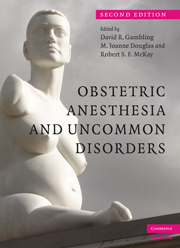Book contents
- Frontmatter
- Contents
- List of plates
- List of contributors
- Preface
- Section 1 Cardiovascular and respiratory disorders
- Section 2 Musculoskeletal disorders
- 5 Myopathies
- 6 Parturients of short stature
- 7 Disorders of the vertebral column
- 8 Miscellaneous skeletal and connective tissue disorders in pregnancy
- Section 3 Nervous system disorders
- Section 4 Metabolic disorders
- Section 5 Other disorders
- Index
- Plate Section
- References
8 - Miscellaneous skeletal and connective tissue disorders in pregnancy
from Section 2 - Musculoskeletal disorders
Published online by Cambridge University Press: 19 October 2009
- Frontmatter
- Contents
- List of plates
- List of contributors
- Preface
- Section 1 Cardiovascular and respiratory disorders
- Section 2 Musculoskeletal disorders
- 5 Myopathies
- 6 Parturients of short stature
- 7 Disorders of the vertebral column
- 8 Miscellaneous skeletal and connective tissue disorders in pregnancy
- Section 3 Nervous system disorders
- Section 4 Metabolic disorders
- Section 5 Other disorders
- Index
- Plate Section
- References
Summary
Introduction
This chapter discusses a variety of miscellaneous conditions found during pregnancy, each with different degrees of rarity. It focuses on the pathophysiologic changes that occur with each disease in order to highlight the impact on both anesthetic and obstetric management. However, as some of the conditions described have a wide and varied organ involvement, firm management conclusions cannot be made. Each case should be assessed individually and the risk/benefit of any given anesthetic choice should be evaluated for each particular patient.
Gorlin syndrome (Gorlin-Golty syndrome or nevoid basal cell carcinoma syndrome)
Gorlin syndrome was first described in 1960. The characteristic features are multiple basal cell nevi, odontogenic keratocysts of the mandible, and other congenital, mostly skeletal, abnormalities. A variety of other neurological, genital, endocrine, and ophthalmic manifestations are also associated with this disease. A predisposition to tumor formation is well documented; those described include ovarian fibromas, central nervous system (CNS) tumors (mostly medulloblastomas), skin, and, occasionally, cardiac tumors. Although this disorder has an autosomal dominant mode of inheritance, 50% arise from spontaneous mutations. The causative gene mutation is located on chromosome 9q22.3, which is normally required for the function of a transmembrane receptor involved in patterning and growth. This Gorlin mutation reduces its ability to act as a tumor suppressor gene resulting in the increased incidence of cancers. Males and females are equally affected and the disease prevalence is about 1 per 60,000. The condition has a variable phenotypic expression with most cases reported in Caucasians.
- Type
- Chapter
- Information
- Obstetric Anesthesia and Uncommon Disorders , pp. 145 - 166Publisher: Cambridge University PressPrint publication year: 2008
References
- 2
- Cited by



